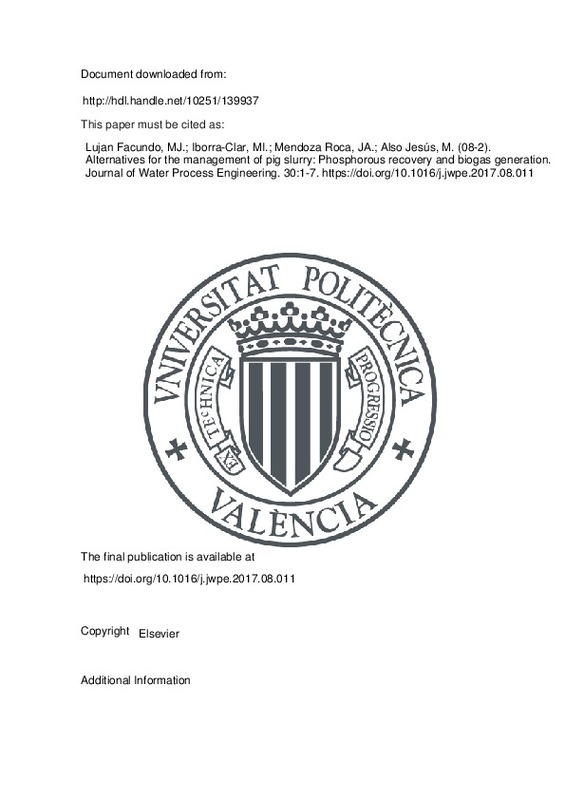JavaScript is disabled for your browser. Some features of this site may not work without it.
Buscar en RiuNet
Listar
Mi cuenta
Estadísticas
Ayuda RiuNet
Admin. UPV
Alternatives for the management of pig slurry: Phosphorous recovery and biogas generation
Mostrar el registro sencillo del ítem
Ficheros en el ítem
| dc.contributor.author | Lujan Facundo, Maria Jose
|
es_ES |
| dc.contributor.author | Iborra-Clar, María Isabel
|
es_ES |
| dc.contributor.author | Mendoza Roca, José Antonio
|
es_ES |
| dc.contributor.author | Also Jesús, M.
|
es_ES |
| dc.date.accessioned | 2020-04-01T07:15:58Z | |
| dc.date.available | 2020-04-01T07:15:58Z | |
| dc.date.issued | 2019-08 | es_ES |
| dc.identifier.uri | http://hdl.handle.net/10251/139937 | |
| dc.description.abstract | [EN] Pig slurry is highly polluted waste stream characterized by its high nutrients content and its high organic matter concentration. In this research, two alternatives in the management of this wastewater were studied. On the one hand, removal of nutrients from piggery wastewater by struvite precipitation was evaluated. Different molar ratios Mg+2/PO4-3, pH and temperatures were tested. On the other hand, an anaerobic treatment was performed with and without previous struvite crystallization and the methane production was analyzed. Results showed that the optimal experimental conditions to achieve the highest ammonium nitrogen and phosphate removal percentages (62.01% and 66.96%, respectively) were a molar concentration ratio (Mg+2/PO4-3) of 2.8, pH of 10 and temperature of 22 degrees C. In addition, images from FE-SEM microscopy demonstrated that the struvite morphology was orthorhombic. Concerning the anaerobic digestion, the chemical oxygen demand removal efficiencies were 59.87% and 52.25% for the treatment without previous struvite precipitation and with previous struvite precipitation, respectively. Furthermore, the maximum biogas potential was found when no previous struvite precipitation was carried out, with a biogas generation around 4 mLh(-1) and a percentage of methane in the biogas between 32.37 and 59.73%. | es_ES |
| dc.description.sponsorship | The authors wish to gratefully acknowledge the financial support from the Spanish Ministry of Economy and Competitiveness through the project PROVIP.ES (RTC-2014-2239-2). | es_ES |
| dc.language | Inglés | es_ES |
| dc.publisher | Elsevier | es_ES |
| dc.relation.ispartof | Journal of Water Process Engineering | es_ES |
| dc.rights | Reserva de todos los derechos | es_ES |
| dc.subject | Pig slurry | es_ES |
| dc.subject | Nutrients | es_ES |
| dc.subject | Struvite | es_ES |
| dc.subject | Anaerobic digestion | es_ES |
| dc.subject.classification | INGENIERIA QUIMICA | es_ES |
| dc.title | Alternatives for the management of pig slurry: Phosphorous recovery and biogas generation | es_ES |
| dc.type | Artículo | es_ES |
| dc.identifier.doi | 10.1016/j.jwpe.2017.08.011 | es_ES |
| dc.relation.projectID | info:eu-repo/grantAgreement/MINECO//RTC-2014-2239-2Q4618002BC.VALENCIANA/ES/Desarrollo de un proceso de Valorización Integral de Purines - PROVIP.es/ | es_ES |
| dc.rights.accessRights | Abierto | es_ES |
| dc.contributor.affiliation | Universitat Politècnica de València. Departamento de Ingeniería Química y Nuclear - Departament d'Enginyeria Química i Nuclear | es_ES |
| dc.description.bibliographicCitation | Lujan Facundo, MJ.; Iborra-Clar, MI.; Mendoza Roca, JA.; Also Jesús, M. (2019). Alternatives for the management of pig slurry: Phosphorous recovery and biogas generation. Journal of Water Process Engineering. 30:1-7. https://doi.org/10.1016/j.jwpe.2017.08.011 | es_ES |
| dc.description.accrualMethod | S | es_ES |
| dc.relation.publisherversion | https://doi.org/10.1016/j.jwpe.2017.08.011 | es_ES |
| dc.description.upvformatpinicio | 1 | es_ES |
| dc.description.upvformatpfin | 7 | es_ES |
| dc.type.version | info:eu-repo/semantics/publishedVersion | es_ES |
| dc.description.volume | 30 | es_ES |
| dc.identifier.eissn | 2214-7144 | es_ES |
| dc.relation.pasarela | S\392956 | es_ES |
| dc.contributor.funder | Ministerio de Economía y Competitividad | es_ES |







![[Cerrado]](/themes/UPV/images/candado.png)

